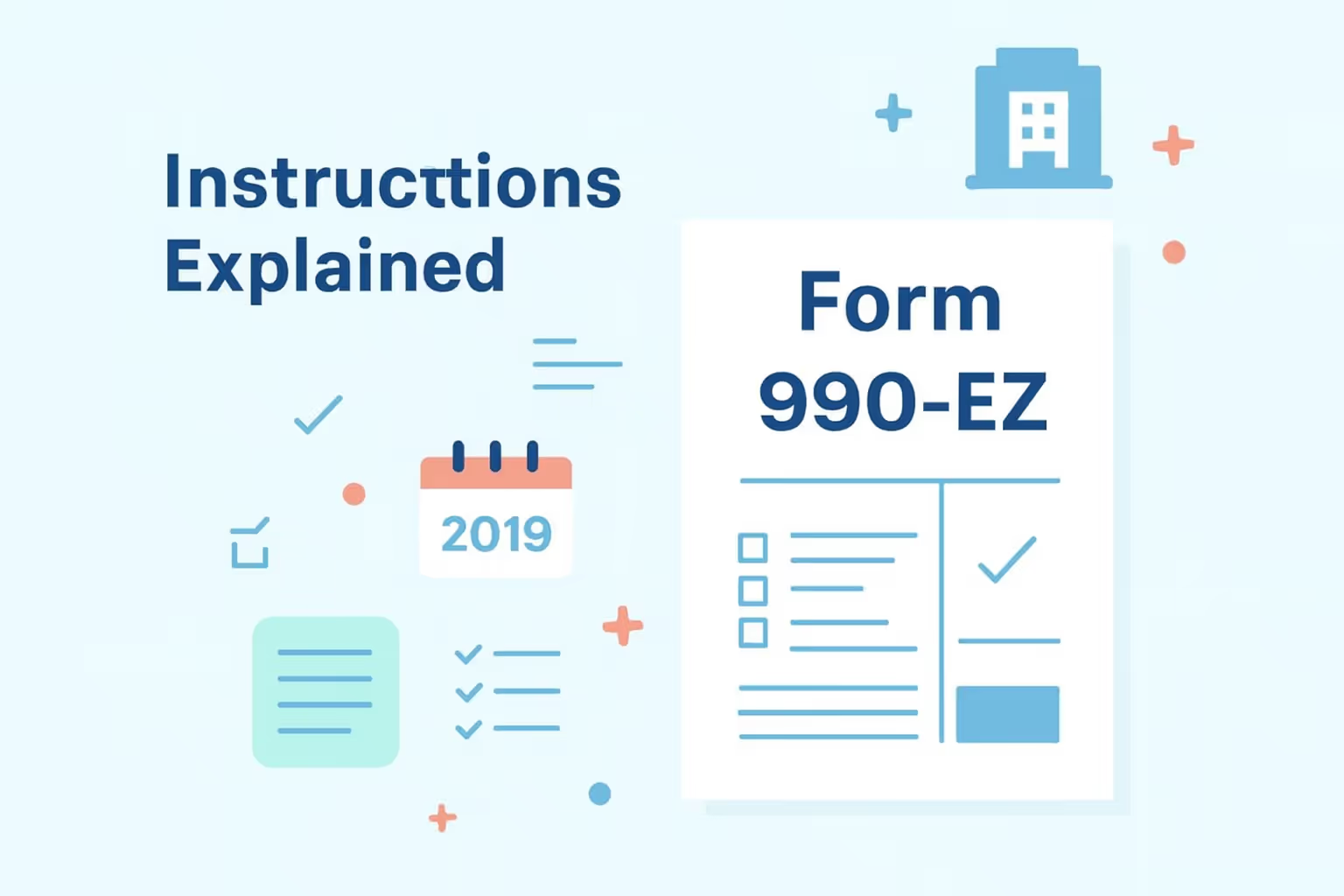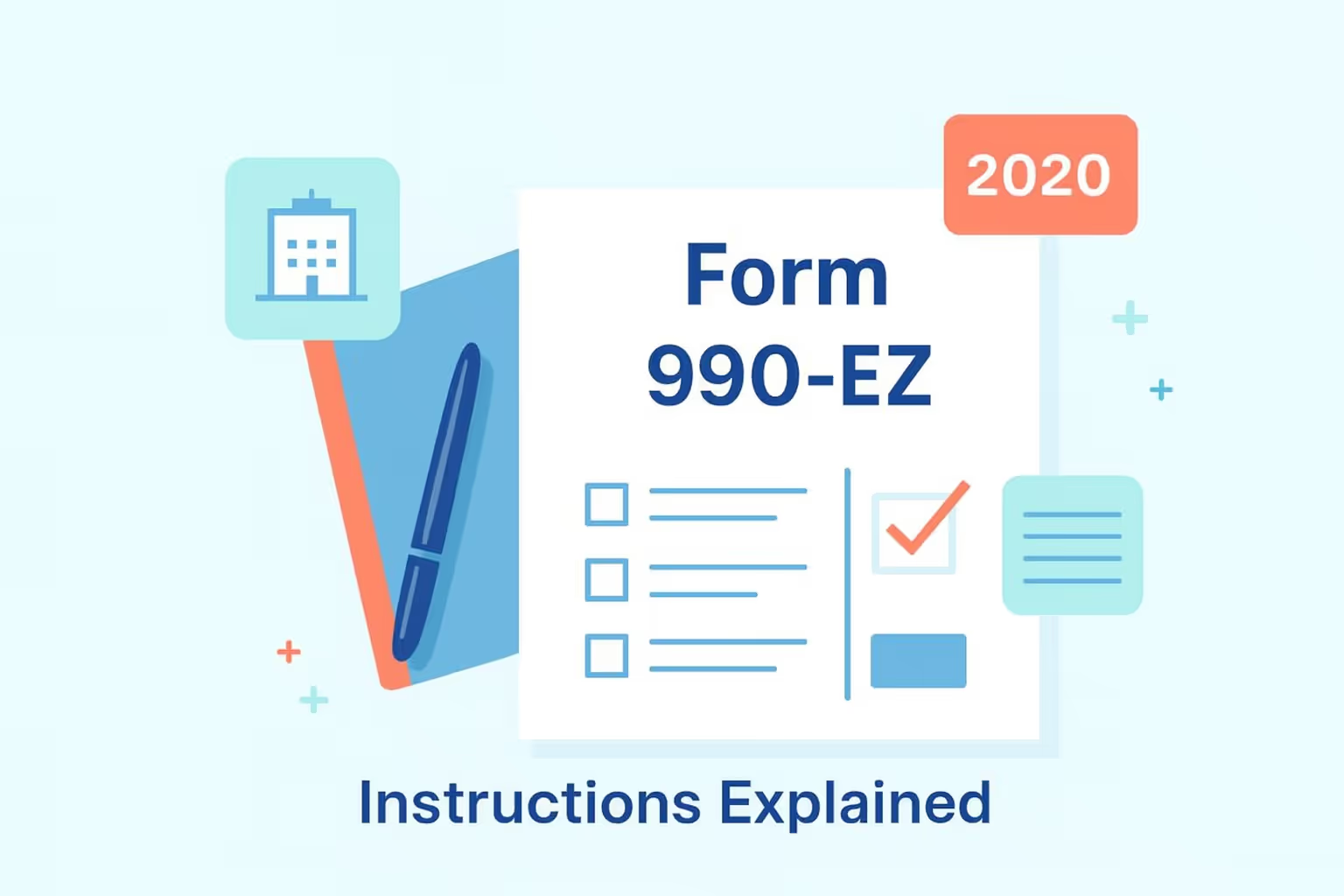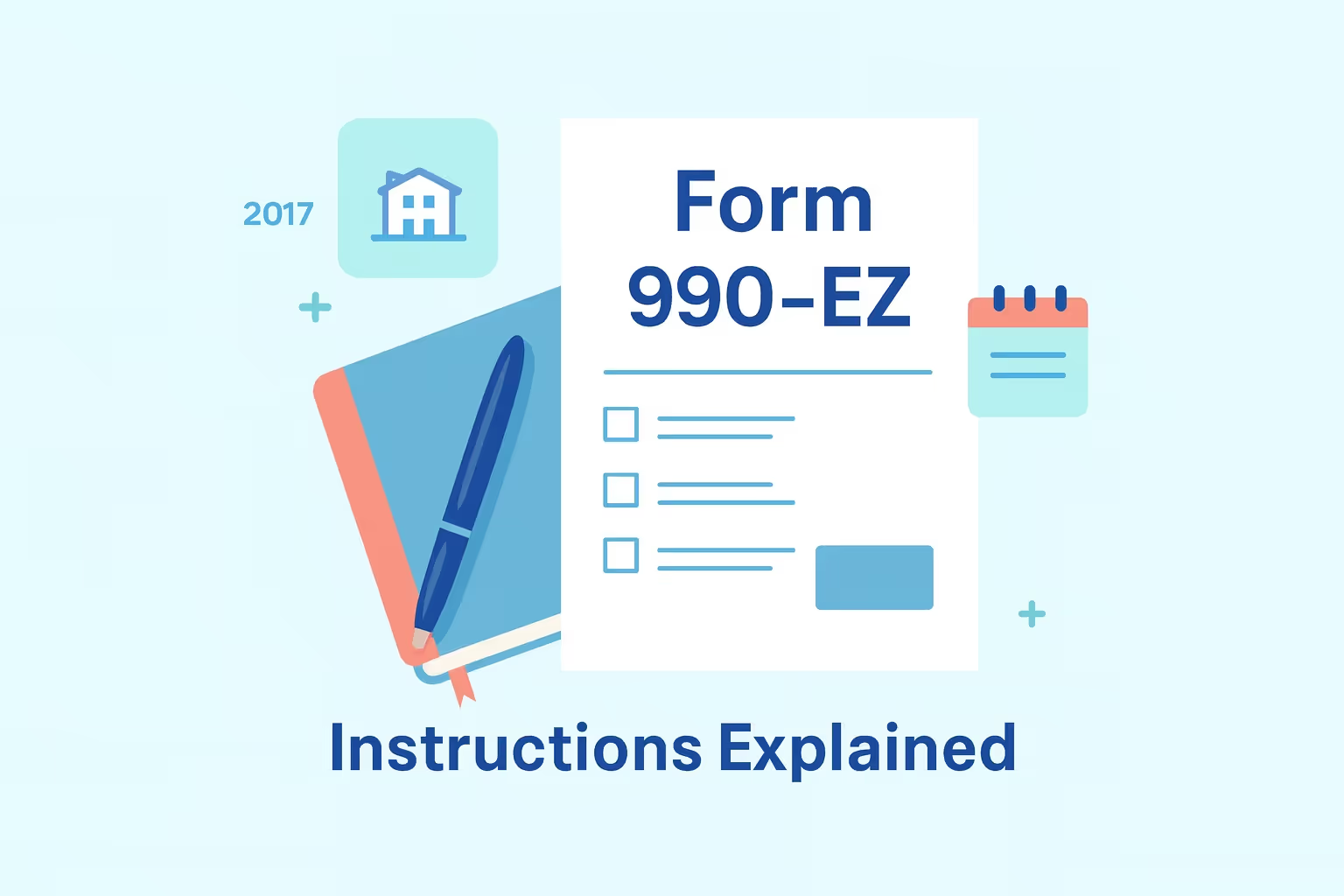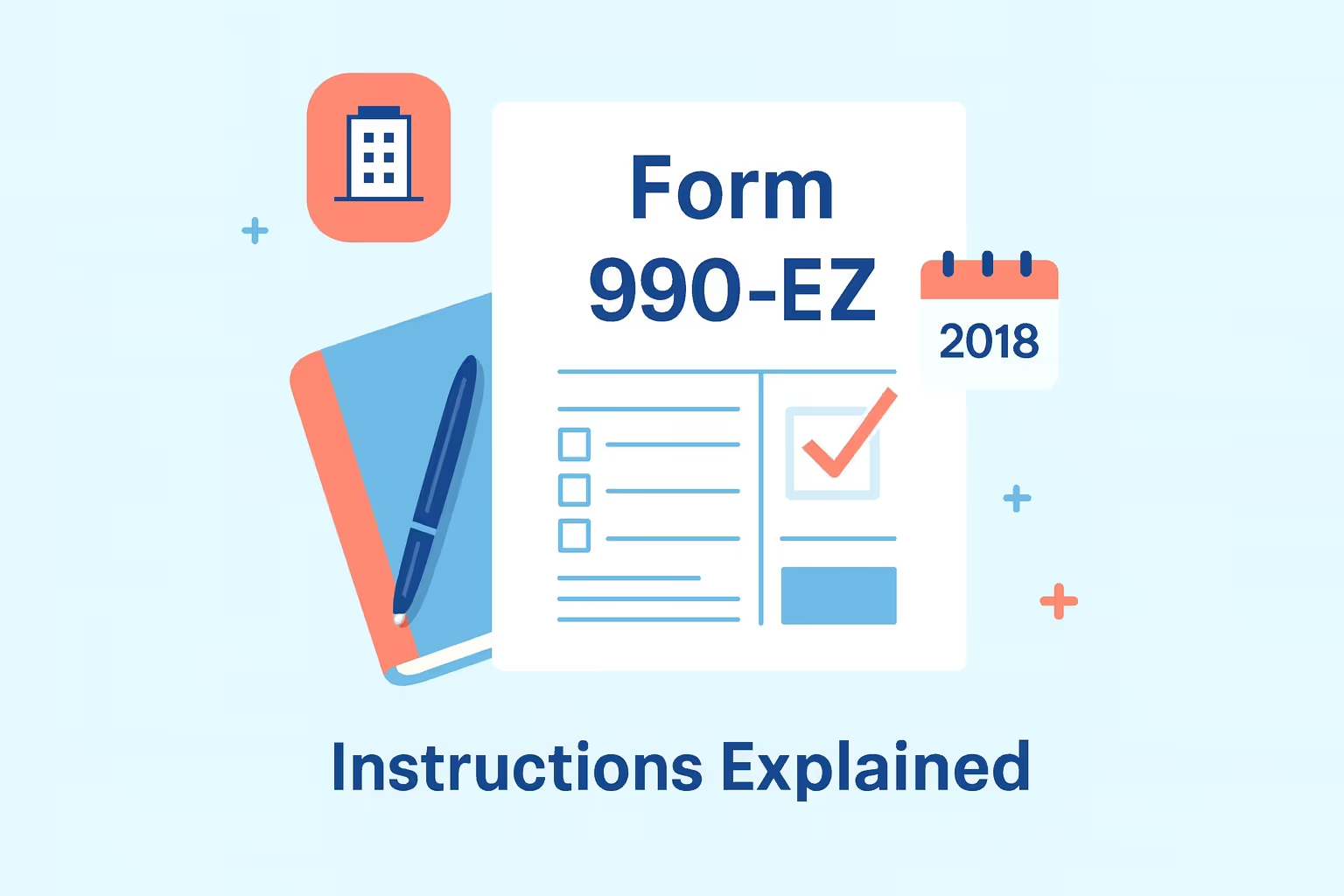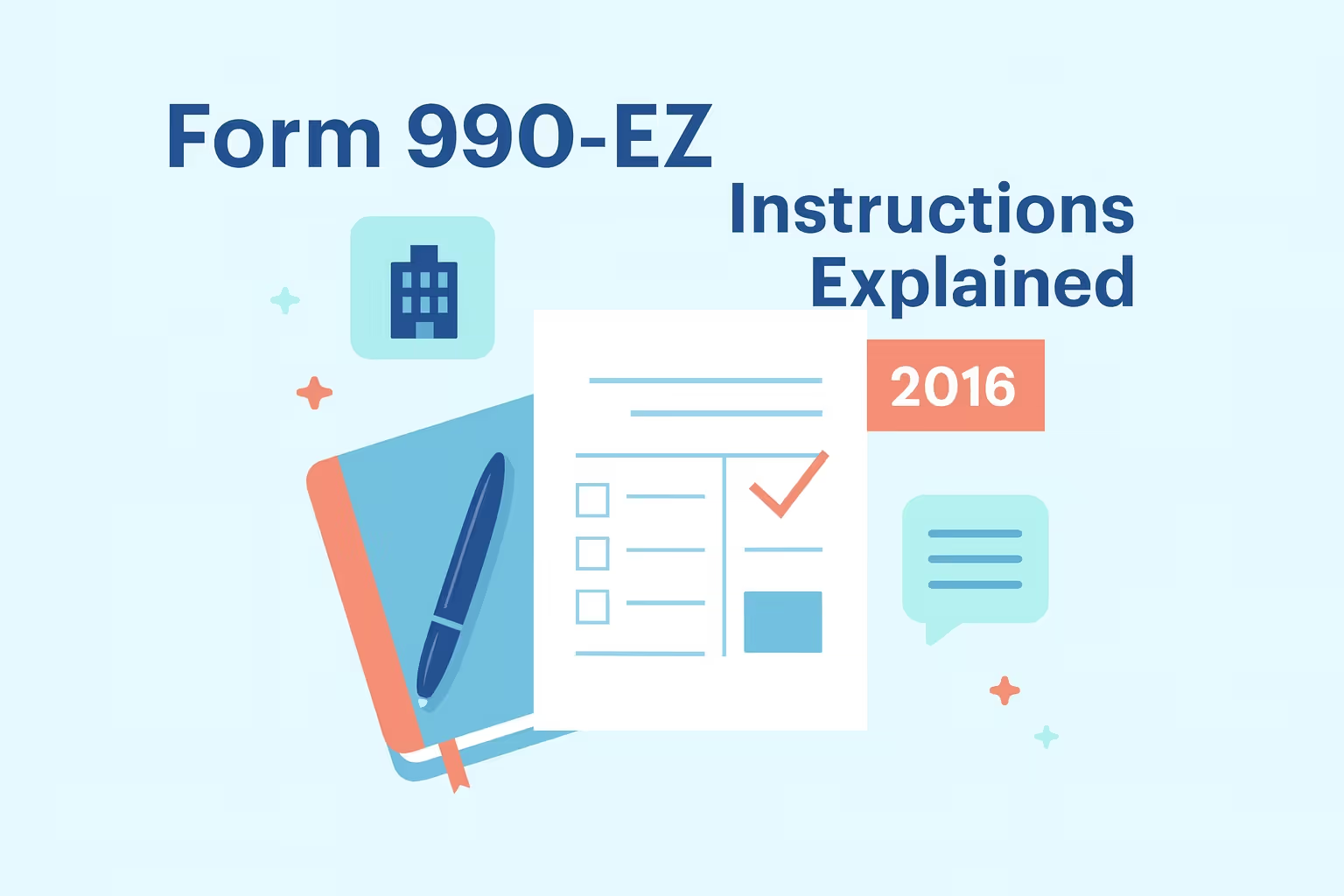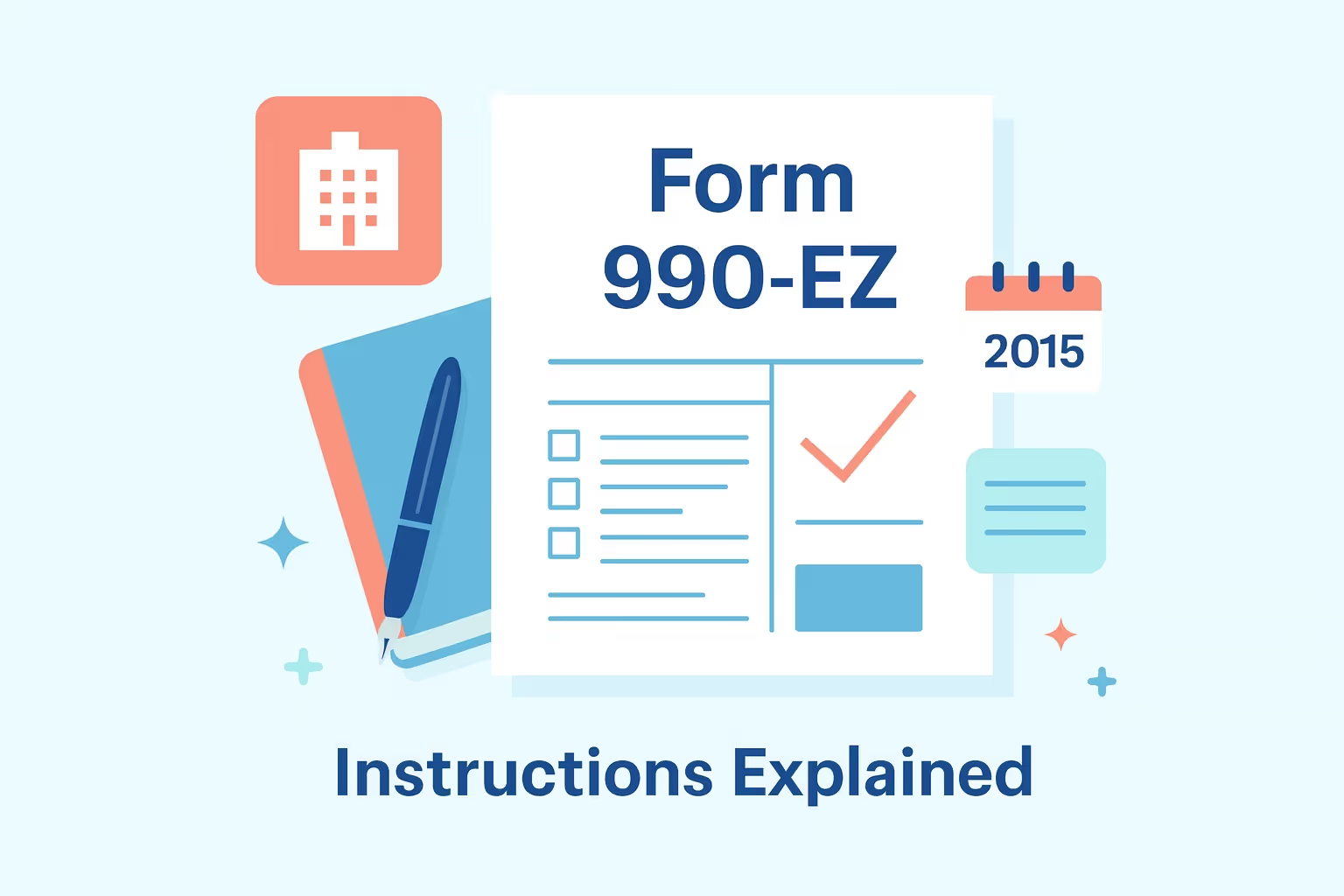How to File Federal Form 990-EZ for Tax Year 2021
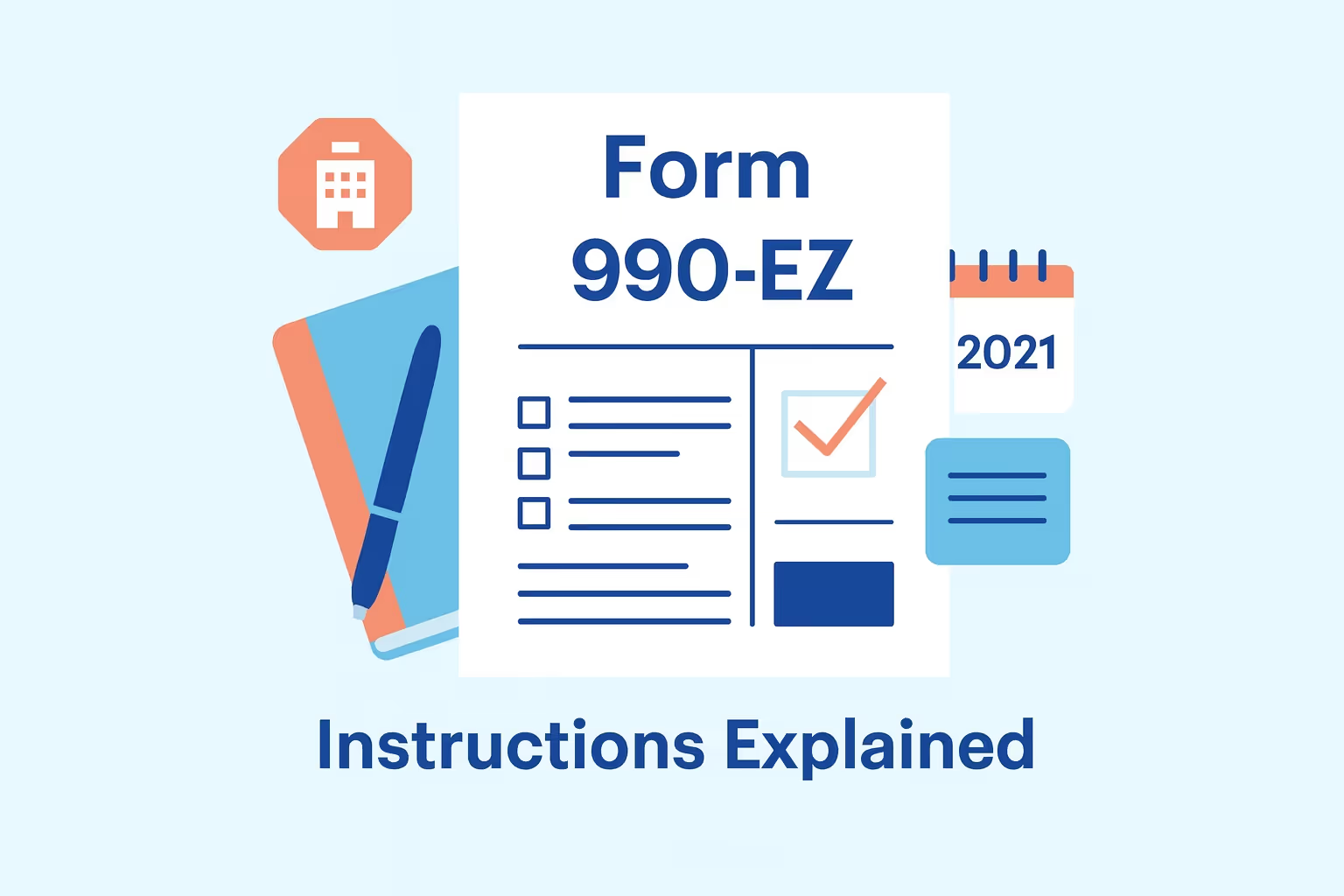
Thousands of small nonprofit organizations lose their tax-exempt status yearly simply because they miss a filing deadline or submit an incomplete return. According to the Internal Revenue Service, failure to file for three consecutive years results in automatic revocation—a costly mistake that can take months to correct. Filing Federal Form 990-EZ for Tax Year 2021 is not just about compliance; it’s about protecting your organization’s reputation, transparency, and legal standing.
For small and mid-sized organizations, Form 990-EZ offers a more straightforward way to report key financial details such as total assets, program service revenue, and fund balances. It helps the IRS verify that your nonprofit remains within federal tax laws while allowing the public to see how your funds are used. Yet, even with its shorter format, many filers make errors—missing attachments, entering net instead of gross receipts, or failing to file electronically—all of which can lead to penalties or delayed processing.
This guide breaks down each step of the filing process clearly and confidently. You’ll learn who qualifies to use Form 990-EZ, how to complete every section accurately, and how to file electronically to comply with federal tax requirements. By following these steps, your organization can file smoothly, avoid costly penalties, and maintain its exempt status with peace of mind.
Understanding Federal Form 990-EZ
Before you start filling out any part of your tax documents, it’s essential to understand what Form 990-EZ is and why it matters. This form gives the Internal Revenue Service a transparent look at your nonprofit’s financial activity, including income, expenses, assets, and compliance with federal tax laws. Whether you’re running a community outreach group or a small educational nonprofit, understanding the structure of this form ensures you meet every requirement correctly.
What Is Federal Form 990-EZ?
Form 990-EZ is the short version of the IRS annual information return required for organizations exempt from federal income tax. It’s designed for smaller entities that must report their net assets, program service accomplishments, and financial transactions without the lengthy disclosures required in Form 990. Filing this form demonstrates your organization’s accountability to donors, members, and government agencies while maintaining its tax-exempt status under the Internal Revenue Code.
Unlike a typical income tax return, Form 990-EZ does not calculate tax owed. Instead, it focuses on transparency. It provides a clear overview of your organization’s mission, program services, and how funds are managed and distributed throughout the year.
Who Should File Form 990-EZ?
Organizations can file Form 990-EZ instead of the longer Form 990 if their gross receipts are less than $200,000 during the tax year and their total assets are less than $500,000 at year-end. This includes tax-exempt organizations such as 501(c)(3) charities, civic leagues, and religious organizations that qualify under section 501(a).
However, some entities must always file the complete Form 990, regardless of size. These include hospital facilities, private foundations, and nonexempt charitable trusts. Each must report its financial details in greater depth to comply with stricter IRS standards.
Why Filing Correctly Matters
Filing correctly is more than a formality; it safeguards your organization. Inaccurate or incomplete filings can trigger late penalties, increase audit risk, and even lose your organization’s tax-exempt status. Filing accurately also ensures continued eligibility for grants and public support. When done correctly, Form 990-EZ is a compliance document and reflects your organization’s integrity and financial stewardship.
What’s New for the 2021 Tax Year
Before filing your return, you should know that the Internal Revenue Service introduced several updates that affect how exempt organizations complete and file their returns. Understanding these changes ensures your organization complies with federal income tax rules and avoids unnecessary processing delays.
Mandatory Electronic Filing
For the 2021 tax year, all qualifying organizations must file Federal Form 990-EZ electronically. Paper submissions are no longer accepted. This update, required by federal law, ensures faster processing and reduces common filing errors. Any organization that submits a paper form will have its return rejected, which may cause penalties or loss of tax-exempt status if deadlines are missed.
Electronic filing is essential for small organizations and federally tax-exempt organizations that rely on accurate and timely submission to remain compliant. Using IRS-approved e-file software or authorized providers ensures that your data is securely transmitted.
Updated Reporting Rules
The IRS also introduced reporting adjustments that continue into 2021. Organizations must now report all nonemployee compensation using Form 1099-NEC instead of Form 1099-MISC. Additionally, section 501(c)(21) Black Lung Benefit Trusts can no longer file Form 990-BL and must instead file Form 990 or, if eligible, submit Form 990-N electronically.
Comparison 1: Key 2020 vs. 2021 IRS Filing Changes for Exempt Organizations
Filing Method
- 2020 Requirement: Paper or e-file allowed
- 2021 Requirement: Mandatory e-file
Form 1099 Reporting
- 2020 Requirement: Reported using Form 1099-MISC
- 2021 Requirement: Required to use Form 1099-NEC (for nonemployee compensation) along with Form 1099-MISC for other payments
Form 990-BL
- 2020 Requirement: Still accepted by the IRS
- 2021 Requirement: Discontinued
By staying informed of these updates, your organization can avoid common filing mistakes and confidently move forward with the next steps in the process.
Step-by-Step Filing Process
Filing Federal Form 990-EZ for Tax Year 2021 is more straightforward than it appears once you understand the structure. Each part of the form focuses on a different aspect of your organization’s financial and operational information. Following the steps below, you can accurately complete the form, reduce the risk of IRS rejection, and ensure your organization fully complies with federal requirements.
Step 1: Complete the Header Information
Start by filling out the header section at the top of Form 990-EZ. This area contains critical identification details about your organization. Include your legal name, employer identification number (EIN), and mailing address, ensuring all information matches your IRS records. Add your organization’s website, if applicable, and specify the correct accounting period by listing your tax year's beginning and ending dates.
Check the appropriate boxes if your organization is filing an amended or final return or has changed its fiscal year. Enter the organization’s gross receipts to confirm eligibility for filing this form. Notably, no Social Security numbers should be included on this form, as it will be made publicly available on the IRS website.
Step 2: Fill Out Part I – Revenue, Expenses, and Changes in Net Assets
This step summarizes your organization’s overall financial activity.
Numbered checklist:
- Report total revenue accurately: Include all program service revenue, investment income, and membership dues in gross amounts. Reporting net figures may result in discrepancies that can delay approval.
- Separate your special events and fundraising activities: List the total proceeds and the related expenses to maintain transparency and compliance with tax laws.
- Ensure consistency in calculations: Double-check that total revenue (line 8) equals the sum of all applicable income sources. Any mismatch could flag your filing for review by the IRS.
Next, complete the expense section (lines 10–16). Include employee compensation, occupancy costs, printing expenses, and professional service fees. End this part by calculating total costs and changes in net assets, ensuring the numbers match your balance sheet.
Step 3: Complete Part II – Balance Sheet
The balance sheet section provides a snapshot of your organization’s financial position. Report assets, liabilities, and fund balances at the beginning and end of the tax year. Use Column A for figures at the start of the year and Column B for the end. Confirm that total assets equal liabilities plus net assets, demonstrating accurate record-keeping. Maintaining a balanced report reassures the IRS and potential donors of your organization’s financial stability.
Step 4: Describe Program Service Accomplishments (Part III)
This section showcases how your organization fulfills its mission through program services. Clearly describe your primary programs, detailing what they achieve and who benefits. For example, a nonprofit providing educational workshops should specify how many sessions were conducted and how many participants were served.
Avoid vague language and quantify your results when possible. This part satisfies IRS requirements and builds public trust by highlighting your tangible community impact.
Step 5: List Officers, Directors, and Key Employees (Part IV)
List all officers, board members, and key employees, even if unpaid. Include their names, titles, and compensation amounts.
Key points:
- The IRS requires all current officers, even volunteers, to be listed for transparency. Failing to list one could delay processing or raise compliance questions.
- Compensation must match payroll or accounting records. Misreporting can result in penalties or loss of confidence in your organization’s financial integrity.
This section also helps confirm that no interested persons or related organizations benefit improperly from the nonprofit’s activities.
Step 6: Provide Other Information (Part V)
Part V includes yes/no questions regarding your organization’s activities, compliance, and relationships with other entities. Read each carefully before responding. Topics include foreign operations, political activities, fundraising methods, and transactions with supporting organizations or independent contractors.
Answer every question, even if the answer is “No.” Leaving questions blank can cause your form to be flagged as incomplete. When additional details are required, use Schedule O for explanations.
Step 7: Complete Section 501(c)(3) Details (Part VI)
You must complete this final section if your organization is classified as a 501(c)(3) public charity. It verifies your public charity status, political campaign compliance, and whether your organization is part of a group exemption under a parent entity.
Be thorough when identifying your group exemption number (GEN) and confirming that your organization operates independently from any political campaign or lobbying effort. Accurate completion of this section preserves your organization’s tax-exempt status under the Internal Revenue Code and helps the IRS determine your eligibility for continued exemption.
How to File Form 990-EZ Electronically
Once your form is complete, the next step is submitting it to the Internal Revenue Service correctly and on time. The 2021 tax year requires electronic filing for all exempt organizations, meaning paper submissions are no longer valid. Filing electronically speeds up processing and helps your organization remain compliant with federal tax laws while avoiding costly penalties.
Electronic Filing Requirements
Filing your Federal Form 990-EZ for Tax Year 2021 must be done through an IRS-authorized e-file provider or professional online filing platform. The IRS provides a list of approved providers on its website to help organizations choose safely.
Numbered checklist:
- Use an approved e-file service: Choose software designed explicitly for tax-exempt organizations. Verify that your provider is listed on the IRS website to ensure your return is accepted without issue.
- Sign the return electronically: An authorized officer, such as the president or assistant treasurer, must sign the form. Missing or incorrect signatures can cause the return to be rejected or incomplete.
- Attach all required schedules: Each schedule—such as Schedule A, B, or O—must be uploaded in electronic format. Attachments should follow IRS formatting rules to prevent submission errors.
- Double-check all financial details: Review every figure in your revenue, expenses, and balance sheet sections. Electronic systems often flag errors automatically, but accuracy depends on your entries.
Filing electronically also allows faster receipt acknowledgment. The IRS will confirm that your form was filed successfully, which you should keep with your organization’s records for at least three years.
Filing Deadlines and Extensions
The filing deadline for calendar year organizations is May 15, 2022. For those operating on a fiscal year, the due date is the 15th day of the fifth month after the organization’s accounting period ends. Missing these deadlines can result in steep penalties and risk your organization’s tax-exempt status.
To request extra time, file Form 8868 for an automatic extension. However, remember that this only extends your filing period, not your payment deadlines for unrelated business income or penalties. Filing early helps avoid last-minute technical issues or delays.
Comparison 2: Electronic Filing Deadlines and Penalties
Calendar Year Filers
- Due Date: May 15, 2022
- Penalty for Late Filing: $20 per day, up to $10,500 or 5% of gross receipts (whichever is less)
Fiscal Year Filers
- Due Date: 15th day of the 5th month after the fiscal year ends
- Penalty for Late Filing: $105 per day if gross receipts exceed $1,094,500
Electronic submission is now the only accepted filing method. Filing accurately and promptly protects your organization’s exempt status, ensures compliance with federal income tax rules, and prevents unnecessary financial loss due to penalties.
Required Schedules and Attachments
After you’ve entered your organization’s financial details, the next important step is attaching all required schedules. The IRS uses these attachments to confirm your organization’s activities, public charity status, and financial statements. Missing or incomplete schedules are among the most common reasons the IRS returns or rejects filings, so reviewing this part carefully is vital.
Commonly Required Schedules
Each schedule serves a unique purpose. The ones listed below are the most frequently required for organizations filing Federal Form 990-EZ for Tax Year 2021:
- Schedule A—Public Charity Status and Public Support: All 501(c)(3) organizations must complete this schedule to verify their public charity status and confirm that they meet public support tests.
- Schedule B – Schedule of Contributors: Required if any donor contributed more than $5,000 during the tax year. The IRS allows most organizations to omit donor names from public copies for transparency.
- Schedule G – Fundraising or Gaming Activities: Needed if your organization hosts fundraising events, raffles, or gaming activities. Provide details on income, prizes, and related sales expenses.
- Schedule O – Supplemental Information: Used to explain complex responses or provide additional context for any section. Many organizations rely on Schedule O to clarify parts III and V responses.
Filing Rules for Schedules
All required schedules must be filed electronically along with your primary return. Paper attachments are not accepted for 2021 filings. Ensure each schedule is in the correct digital format before uploading through your e-file software.
The IRS recommends verifying which schedules apply to your organization by reviewing the IRS instructions and Form 990-EZ checklist available on the IRS website. Submitting complete and accurate schedules helps demonstrate transparency and ensures your organization’s exempt status remains in good standing.
Common Errors and How to Avoid Them
Even small mistakes can delay your filing or result in penalties. Many tax-exempt organizations unintentionally lose their exempt status because of avoidable errors in their IRS filings. Reviewing the most common issues before submission helps protect your organization’s compliance and reputation.
Frequent Filing Mistakes
- Leaving blank lines or incomplete answers: Every question on Federal Form 990-EZ for Tax Year 2021 must be answered. Enter “0” for zero amounts rather than leaving any field empty, as the IRS treats blanks as missing data.
- Reporting net instead of gross amounts: Always report total revenue, including program service revenue and contributions, before expenses. This ensures your financial records match your financial statements and prevents mismatched totals.
- Incorrectly balancing the financial report: Verify that total assets equal liabilities plus net assets on your balance sheet. Errors here can raise red flags for potential misreporting or calculation mistakes.
- Using outdated or unauthorized forms: Only use the official IRS form for 2021 from the IRS website. Submitting older or altered versions may result in rejection.
- Paper filing when electronic filing is required: Paper submissions are no longer accepted. Returns not filed electronically are considered unfiled and may lead to penalties.
Signature and Authorization Problems
Each return must be signed by an authorized officer—such as the president, treasurer, or assistant treasurer—using the correct electronic verification method. Missing or incorrect signatures render the form invalid.
Avoiding Penalties
Before submission, perform a final review of all data, schedules, and signatures. The IRS may impose penalties of $20 per day, up to $10,500 or 5% of the organization’s gross receipts, for incomplete or late filings. Checking your return thoroughly protects your organization’s tax-exempt status and avoids unnecessary fines.
Conclusion
Filing Federal Form 990-EZ for Tax Year 2021 is more than a yearly task; it safeguards your organization’s credibility and legal compliance. Even smaller tax-exempt organizations must treat it seriously to protect their exempt status and maintain public trust.
Your organization can remain compliant and transparent by filing electronically, double-checking schedules, and submitting accurate financial statements. Late or incorrect filings often result in unnecessary penalties and delayed approvals—problems that can be easily avoided with preparation.
Take the time to review your organization’s gross receipts, verify your public charity status, and ensure every part of your IRS Form 990-EZ is complete. Careful attention to detail now saves your nonprofit time and money and the risk of losing its federal income tax exemption later.
FAQs
What happens if a tax-exempt organization misses the filing deadline?
Missing the filing deadline can result in penalties of $20 per day, up to $10,500 or 5% of the organization’s annual gross receipts. Larger organizations may face $105 per day in fines if receipts exceed $1,094,500. Failure to file for three consecutive years causes the Internal Revenue Service to automatically revoke tax-exempt status, which can take months to reinstate.
Can private foundations file Form 990-EZ?
Private foundations cannot file Form 990-EZ. They must submit Form 990-PF instead, as the Internal Revenue Code requires. Only smaller public charities or other qualifying tax-exempt organizations may use Form 990-EZ. Review the IRS instructions or contact a tax professional before filing to confirm which form applies to avoid processing delays or rejections.
How should in-kind or donated goods be reported?
In-kind donations, such as property or supplies, should be listed at fair market value as part of program service revenue. Significant noncash contributions may also require Schedule M. Reporting donations correctly ensures your financial statements reflect accurate fund balances and helps your organization comply with federal tax laws governing exempt organizations and their public charity status.
What if my organization operates under a group exemption letter?
Organizations that operate under a group exemption letter must include their group exemption number on Form 990-EZ. This allows the IRS to associate the filing with the parent entity and maintain group exemption compliance. Each organization must still complete its return accurately to comply with tax code requirements and federal income tax reporting rules.
Where can I find updated guidance on Form 990-EZ?
The best source for official filing instructions is the IRS website. It provides the latest IRS forms, updated e-file provider lists, and related information for exempt organizations. Use official government resources rather than third-party summaries to ensure your return meets all current requirements for Federal Form 990-EZ for Tax Year 2021 and remains fully compliant.
















